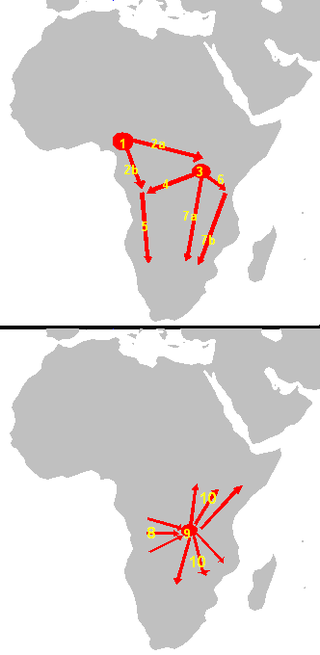Bantu peoples
Bantu peoples are the speakers of Bantu languages, comprising several hundred indigenous ethnic groups in sub-Saharan Africa, spread over a vast area from Central Africa across the African Great Lakes to Southern Africa.[1] Linguistically, these languages belong to the Southern Bantoid branch of Benue–Congo, one of the language families grouped within the Niger–Congo phylum.
| Regions with significant populations | |
|---|---|
| African Great Lakes, Central Africa, Southern Africa | |
| Languages | |
| Bantu languages (over 535) | |
| Religion | |
| Predominantly Christianity, traditional faiths; minority Islam | |
| Related ethnic groups | |
| Niger–Congo |
The total number of languages ranges in the hundreds, depending on the definition of "language" or "dialect", estimated at between 440 and 680 distinct languages.[2] The total number of speakers is in the hundreds of millions, ranging at roughly 350 million in the mid-2010s (roughly 30% of the population of Africa, or roughly 5% of the total world population).[3] About 60 million speakers (2015), divided into some 200 ethnic or tribal groups, are found in the Democratic Republic of Congo alone.
The larger of the individual Bantu groups have populations of several million, e.g. the Shona of Zimbabwe (12 million as of 2000), the Zulu of South Africa (12 million as of 2005) the Luba of the Democratic Republic of the Congo (7 million as of 2010), the Sukuma of Tanzania (9 million as of 2016), or the Kikuyu of Kenya (8 million as of 2019).
Origin of the Category Name Bantu
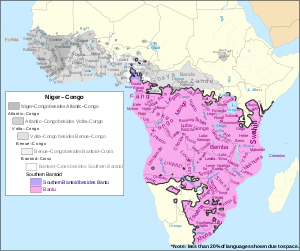
The word Bantu for the language families and its speakers is an artificial term based on the reconstructed Proto-Bantu term for "people" or "humans". It was first introduced (as Bâ-ntu) by Wilhelm Bleek in 1857 or 1858, and popularised in his Comparative Grammar of 1862.[4] The name was coined to represent the word for "people" in loosely reconstructed Proto-Bantu, from the plural noun class prefix *ba- categorizing "people", and the root *ntʊ̀ - "some (entity), any" (e.g. Zulu umuntu "person", abantu "people", into "thing", izinto "things"). There is no native term for the peoples who speak Bantu languages, because they are not an ethnic group. People speaking Bantu languages refer to their languages by ethnic endonyms, which did not have an indigenous concept prior to European contact for the larger ethno-linguistic phylum named by 19th century European linguists. Bleek's coinage was inspired by the anthropological observation of groups self-identifying as "people" or "the true people".[5] That is, idiomatically the reflexes of *bantʊ in the numerous languages often have connotations of personal character traits as encompassed under the values system of ubuntu, also known as hunhu in Chishona or botho in Sesotho, rather than just referring to all human beings.
The root in Proto-Bantu is reconstructed as *-ntʊ́. Versions of the word Bantu (that is, the root plus the class 2 noun class prefix *ba-) occur in all Bantu languages: for example, as bantu in Kikongo and Kituba; watu in Swahili; anthu in Chichewa; batu in Lingala; bato in Kiluba; bato in Duala; abanto in Gusii; andũ in Kamba and Kikuyu; abantu in Kirundi, Zulu, Xhosa, Runyakitara,[6] and Ganda; wandru in Shingazidja; abantru in Mpondo and Ndebele; bãthfu in Phuthi; bantfu in Swati and Bhaca ; banu in Lala; vanhu in Shona and Tsonga; batho in Sesotho, Tswana and Northern Sotho; antu in Meru; andu in Embu; vandu in some Luhya dialects; vhathu in Venda and bhandu in Nyakyusa.
History
Origins and expansion
Bantu languages are theorised to derive from the Proto-Bantu reconstructed language, estimated to have been spoken about 4,000 to 3,000 years ago in West/Central Africa (the area of modern-day Cameroon). They were supposedly spread across Central, Eastern and Southern Africa in the so-called Bantu expansion, a comparatively rapid dissemination taking roughly two millenia and dozens of human generations during the 1st millennium BCE and the 1st millenium CE,[10] This concept has often been framed as a mass-migration, but Jan Vansina and others have argued that it was actually a cultural spread and not the movement of any specific populations that could be defined as an enormous group simply on the basis of common language traits.
The geographical shape and course of the Bantu expansion remains debated. Two main scenarios are proposed, an early expansion to Central Africa, and a single origin of the dispersal radiating from there,[11] or an early separation into an eastward and a southward wave of dispersal, with one wave moving across the Congo basin towards East Africa, and another moving south along the African coast and the Congo River system towards Angola.[12] Genetic analysis shows a significant clustered variation of genetic traits among Bantu language speakers by region, suggesting admixture from prior local populations.
According to the early-split scenario as described in the 1990s, the southward dispersal had reached the Central African rain forest by about 1500 BCE, and the southern Savannahs by 500 BCE, while the eastward dispersal reached the Great Lakes by 1000 BCE, expanding further from there, as the rich environment supported dense populations. Possible movements by small groups to the southeast from the Great Lakes region could have been more rapid, with initial settlements widely dispersed near the coast and near rivers, due to comparatively harsh farming conditions in areas farther from water. Recent archeological and linguistic evidence about population movements suggests that pioneering groups would have had reached parts of modern KwaZulu-Natal in South Africa sometime prior to the 3rd century AD along the coast, and the modern Northern Province (encompassed within the former province of the Transvaal) by AD 500.[13]
Under the Bantu expansion migration hypothesis, various Bantu-speaking peoples would have assimilated and/or displaced many earlier inhabitants, with only a few modern peoples such as Pygmy groups in central Africa, the Hadza people in northern Tanzania, and various Khoisan populations across southern Africa retaining autonomous existence into the era of European contact. Archeological evidence attests to their presence in areas subsequently occupied by Bantu-speakers. Bantu-speaking migrants would have also interacted with some Afro-Asiatic outlier groups in the southeast (mainly Cushitic),[14][15] as well as Nilotic and Central Sudanic speaking groups. Cattle terminology in use amongst the relatively few modern Bantu pastoralist groups suggests that the acquisition of cattle may have been from Cushitic-speaking neighbors. Linguistic evidence also indicates that the customs of milking cattle were also directly modeled from Cushitic cultures in the area.[16] Cattle terminology in southern African Bantu languages differs from that found among more northerly Bantu-speaking peoples. One recent suggestion is that Cushitic-speakers had moved south earlier, and interacted with the most northerly of Khoisan-speakers who acquired cattle from them, and that the earliest arriving Bantu-speakers in turn got their initial cattle from Cushitic-influenced Khwe-speaking people. Under this hypothesis, larger later Bantu-speaking immigration subsequently displaced or assimilated that southernmost extension of the range of Cushitic-speakers.[17][18]
Later history
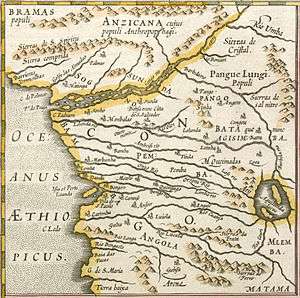
Between the 9th and 15th centuries, Bantu-speaking states began to emerge in the Great Lakes region and in the savannah south of the Central African rain forest. On the Zambezi river, the Monomatapa kings built the Great Zimbabwe complex, a civilisation ancestral to the Kalanga people.[19] Comparable sites in Southern Africa, include Bumbusi in Zimbabwe and Manyikeni in Mozambique.
From the 12th century onward, the processes of state formation amongst Bantu peoples increased in frequency. This was probably due to denser population (which led to more specialized divisions of labor, including military power, while making emigration more difficult); to technological developments in economic activity; and to new techniques in the political-spiritual ritualization of royalty as the source of national strength and health.[20] Some examples of such Bantu states include: in Central Africa, the Kingdom of Kongo, the Kuba Kingdom, the Lunda Empire, the Luba Empire, Tooro, Bunyoro, Buganda, Busoga, Rwanda, Burundi, Ankole and in Southern Africa, the Mutapa Empire, the Zulu Kingdom, the Ndebele Kingdom, Mapungubwe, the Kingdom of Butua, Maravi, Danamombe, Khami, Naletale, Kingdom of Zimbabwe[21] and the Rozwi Empire.[22]
On the coastal section of East Africa, a mixed Bantu community developed through contact with Muslim Arab and Persian traders, Zanzibar being an important part in the Arab slave trade. The Swahili culture that emerged from these exchanges evinces many Arab and Islamic influences not seen in traditional Bantu culture, as do the many Afro-Arab members of the Bantu Swahili people. With its original speech community centered on the coastal parts of Zanzibar, Kenya, and Tanzania – a seaboard referred to as the Swahili Coast – the Bantu Swahili language contains many Arabic loan-words as a result of these interactions.[23] The Arab slave trade also brought Bantu influence to Madagascar,[24] the Malagasy people showing Bantu admixture, and their Malagasy language Bantu loans.[25] Toward the 18th and 19th centuries, the flow of Zanj (Bantu) slaves from Southeast Africa increased with the rise of the Omani Sultanate of Zanzibar, based in Zanzibar, Tanzania. With the arrival of European colonialists, the Zanzibar Sultanate came into direct trade conflict and competition with Portuguese and other Europeans along the Swahili Coast, leading eventually to the fall of the Sultanate and the end of slave trading on the Swahili Coast in the mid-20th century.
List of Bantu groups by country
| Country | Total population (millions, 2015 est.) |
% Bantu | Bantu population (millions, 2015 est.) |
Zones | Bantu groups |
|---|---|---|---|---|---|
| Democratic Republic of the Congo | 77 | 80% | 62 | B, C, D, H, J, K, L, M | Bakongo, Mongo, Baluba, numerous others ( Ambala, Ambuun, Angba, Babindi, Baboma, Baholo, Balunda, Bangala, Bango, Batsamba, Bazombe,Bemba, Bembe, Bira, Bowa, Dikidiki, Dzing, Fuliru, Havu, Hema, Hima, Hunde, Hutu, Iboko, Kanioka, Kaonde, Kuba, Komo, Kwango, Lengola, Lokele, Lupu, Lwalwa, Mbala, Mbole, Mbuza (Budja), Nande, Ngoli, Bangoli, Ngombe, Nkumu,Nyanga, Pende, Popoi, Poto, Sango, Shi, Songo, Sukus, Tabwa, Tchokwé, Téké, Tembo, Tetela, Topoke, Ungana, Vira, Wakuti, Yaka, Yakoma, Yanzi, Yeke, Yela, total 80% Bantu) |
| Tanzania | 51 | 90%? | c. 45 | E, F, G, J, M, N, P | Sukuma, Nyamwezi,Haya,Chaga,Gogo,Makonde,Ngoni,Matumbi, numerous others (majority Bantu) |
| South Africa | 55 | 75% | 40 | S | Nguni (Zulu, Hlubi, Xhosa, Ndebele,Swazi), Basotho (South Sotho), Bapedi (North Sotho), Venda, Tswana, Tsonga, Kgaga (North Sotho),[26] total 75% Bantu |
| Kenya | 46 | 80% | 37 | E, J | Kikuyu, Luhya, Maragoli, Kamba, Kisii, Meru, Kuria, Aembu, Ambeere,Taita, Pokomo, Taveta and Mijikenda, numerous others (80% Bantu) |
| Mozambique | 28 | 99% | 28 | N, P, S | Makua, Sena, Shona (Ndau), Shangaan (Tsonga), Makonde, Yao, Swahili, Tonga, Chopi, Ngoni |
| Uganda | 37 | 70%? | c. 25 | D, J | Baganda,Basoga,Gwere,Banyoro,Nkole,Kiga,Tooro,Masaba,Samia,Konjo,Bafumbira, (majority Bantu) |
| Angola | 26 | 97% | 25 | H, K, R | Ovimbundu, Ambundu, Bakongo, Chokwe, Lunda, Ganguela, Ovambo, Herero, Xindonga (97% Bantu) |
| Malawi | 16 | 99% | 16 | N | Chewa,Tumbuka, Yao, Lomwe, Sena, Tonga, Ngoni, Ngonde |
| Zambia | 15 | 99% | 15 | L, M, N | Nyanja-Chewa, Bemba, Tonga, Tumbuka, Lunda, Luvale, Kaonde, Nkoya and Lozi, about 70 groups total. |
| Zimbabwe | 14 | 99% | 14 | S | Shona, Ndebele,tjiKalanga, numerous minor groups. |
| Rwanda | 11 | 99% | 11 | J | Banyarwanda |
| Burundi | 10 | 99% | 10 | J | Barundi |
| Cameroon | 22 | 30% | 6 | A | Bulu, Duala, Ewondo,Bassa,Bakoko,Barombi,Bankon, Subu,Bakwe,Oroko, Fang, Bekpak, 30% Bantu |
| Republic of the Congo | 5 | 97% | 5 | B, C | Kongo, Sangha, M'Bochi, Teke |
| Botswana | 2.2 | 90% | 2.0 | R, S | Tswana or Setswana, Kalanga, Yeyi 90% Bantu |
| Equatorial Guinea | 2.0 | 95% | 1.9 | A | Fang, Bubi, 95% Bantu |
| Lesotho | 1.9 | 99% | 1.9 | S | Sotho |
| Gabon | 1.9 | 95% | 1.8 | B | Fang,Nzebi,Myene, Kota, Shira, Puru, Kande. |
| Namibia | 2.3 | 70% | 1.6 | K, R | Ovambo, Kavango, Herero, Himba, Yeyi 70% Bantu |
| Swaziland | 1.1 | 99% | 1.1 | S | Swazi, Zulu, Tsonga |
| Somalia | 14 | 7% | 1 | E | Somalian Bantu |
| Comoros | 0.8 | 99% | 0.8 | E, G | Comorian people |
| Sub-Saharan Africa | 970[27] | c. 37% | c. 360 |
Use of the term "Bantu" in South Africa
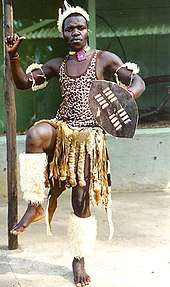
In the 1920s, relatively liberal South Africans, missionaries, and the small black intelligentsia began to use the term "Bantu" in preference to "Native". After World War II, the National Party governments adopted that usage officially, while the growing African nationalist movement and its liberal allies turned to the term "African" instead, so that "Bantu" became identified with the policies of apartheid. By the 1970s this so discredited "Bantu" as an ethno-racial designation that the apartheid government switched to the term "Black" in its official racial categorizations, restricting it to Bantu-speaking Africans, at about the same time that the Black Consciousness Movement led by Steve Biko and others were defining "Black" to mean all non-European South Africans (Bantus, Khoisan, Coloureds, and Indians).
Examples of South African usages of "Bantu" include:
- One of South Africa's politicians of recent times, General Bantubonke Harrington Holomisa (Bantubonke is a compound noun meaning "all the people"), is known as Bantu Holomisa.
- The South African apartheid governments originally gave the name "bantustans" to the eleven rural reserve areas intended for nominal independence to deny indigenous Bantu South Africans citizenship. "Bantustan" originally reflected an analogy to the various ethnic "-stans" of Western and Central Asia. Again association with apartheid discredited the term, and the South African government shifted to the politically appealing but historically deceptive term "ethnic homelands". Meanwhile, the anti-apartheid movement persisted in calling the areas bantustans, to drive home their political illegitimacy.
- The abstract noun ubuntu, humanity or humaneness, is derived regularly from the Nguni noun stem -ntu in Xhosa, Zulu, and Ndebele. In Swati the stem is -ntfu and the noun is buntfu.
- In the Sotho–Tswana languages of southern Africa, batho is the cognate term to Nguni abantu, illustrating that such cognates need not actually look like the -ntu root exactly. The early African National Congress of South Africa had a newspaper called Abantu-Batho from 1912–1933, which carried columns in English, Zulu, Sotho, and Xhosa.
Gallery
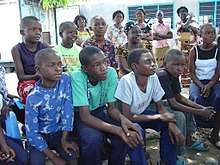
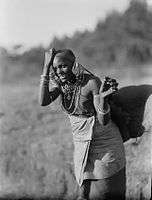 A Kikuyu woman in Kenya
A Kikuyu woman in Kenya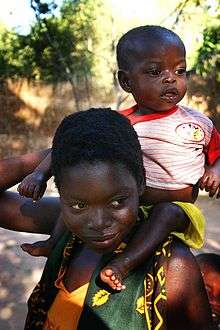 A Makua mother and child in Mozambique
A Makua mother and child in Mozambique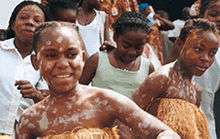 Bubi girls in Equatorial Guinea
Bubi girls in Equatorial Guinea
See also
- African Pygmies
- Bantu mythology
- Congoid
- Demographics of Africa
- Genetic history of Sub-Saharan Africa
- History of West Africa
- Khoisan
- Languages of Africa
- List of ethnic groups of Africa
Notes
- Butt, John J. (2006). The Greenwood Dictionary of World History. Greenwood Publishing Group. p. 39. ISBN 978-0-313-32765-0.
- "Guthrie (1967-71) names some 440 Bantu 'varieties', Grimes (2000) has 501 (minus a few 'extinct' or 'almost extinct', Bastin et al. (1999) have 542, Maho (this volume) has some 660, and Mann et al. (1987) have c. 680." Derek Nurse, 2006, "Bantu Languages", in the Encyclopedia of Language and Linguistics, p. 2. Ethnologue's report for Southern Bantoid lists a total of 535 languages. The count includes 13 Mbam languages which are not always included under "Narrow Bantu".
- Total population cannot be established with any accuracy due to the unavailability of precise census data from Sub-Saharan Africa. A number just above 200 million was cited in the early 2000s (see Niger-Congo languages: subgroups and numbers of speakers for a 2007 compilation of data from SIL Ethnologue, citing 210 million). Population estimates for West-Central Africa were recognized as significantly too low by the United Nations Department of Economic and Social Affairs in 2015 ("World Population Prospects: The 2016 Revision – Key Findings and Advance Tables" (PDF). United Nations Department of Economic and Social Affairs, Population Division. July 2016. Archived from the original (PDF) on 26 June 2019. Retrieved 26 June 2017.). Population growth in Central-West Africa as of 2015 is estimated at between 2.5% and 2.8% p.a., for an annual increase of the Bantu population by about 8 to 10 million.
- Raymond O. Silverstein, "A note on the term 'Bantu' as first used by W. H. I. Bleek", African Studies 27 (1968), 211–212, doi:10.1080/00020186808707298.
- R.K.Herbert and R. Bailey in Rajend Mesthrie (ed.), Language in South Africa (2002), p. 50.
- Bunyoro-Kitara Kingdom; ARKBK CLBG. "Banyoro – Bunyoro-Kitara Kingdom (Rep. Uganda) – The most powerful Kingdom in East Africa!". Retrieved 13 May 2015.
- The Chronological Evidence for the Introduction of Domestic Stock in Southern Africa Archived March 25, 2009, at the Wayback Machine
- "Botswana History Page 1: Brief History of Botswana". Retrieved 13 May 2015.
- "5.2 Historischer Überblick". Archived from the original on 17 January 2010. Retrieved 13 May 2015.
- Philip J. Adler, Randall L. Pouwels, World Civilizations: To 1700 Volume 1 of World Civilizations, (Cengage Learning: 2007), p.169.
- Vansina, J. (1995). "New Linguistic Evidence and the Bantu Expansion'". Journal of African History. 36 (2): 173–195. doi:10.1017/S0021853700034101. JSTOR 182309.
- Pollard, Elizabeth; Rosenberg, Clifford; Tignor, Robert (2011). Worlds Together, Worlds Apart: A History of the World: From the Beginnings of Humankind to the Present. New York: Norton. p. 289.
- Newman (1995), Ehret (1998), Shillington (2005)
- Toyin Falola, Aribidesi Adisa Usman, Movements, borders, and identities in Africa, (University Rochester Press: 2009), pp.4-5.
- Fitzpatrick, Mary (1999). Tanzania, Zanzibar & Pemba. Lonely Planet. p. 39. ISBN 978-0-86442-726-7.
- J. D. Fage, A history of Africa, Routledge, 2002, p.29
- Roger Blench, "Was there an interchange between Cushitic pastoralists and Khoisan speakers in the prehistory of Southern Africa and how can this be detected?" Archived January 21, 2012, at the Wayback Machine
- Robert Gayre, Ethnological elements of Africa, (The Armorial, 1966), p. 45
- The Rebirth of Bukalanga: A Manifesto for the Liberation of a Great People with a Proud History Part I ISBN 978-0-7974-4968-8 ©Ndzimu-unami Emmanuel, 2012, page 100
- Shillington (2005)
- Roland Oliver, et al. "Africa South of the Equator," in Africa Since 1800. Cambridge, UK: Cambridge University Press, 2005, pp. 21-25.
- Isichei, Elizabeth Allo, A History of African Societies to 1870 Cambridge University Press, 1997, ISBN 978-0-521-45599-2 page 435
- Daniel Don Nanjira, African Foreign Policy, and Diplomacy: From Antiquity to the 21st Century, ABC-CLIO, 2010, p.114
- Cambridge World History of Slavery The Cambridge World History of Slavery: The ancient Mediterranean world. By Keith Bradley, Paul Cartledge. pg. 76 (2011), accessed February 15, 2012
- On the Origins and Admixture of Malagasy: New Evidence from High-Resolution Analyses of Paternal and Maternal Lineages
- THE ROLE OF THE YOUTH IN THE STRUGGLE AGAINST THE APARTHEID REGIME IN THABAMOOPO DISTRICT OF THE LEBOWA HOMELAND, 1970 -1994: A CRITICAL HISTORICAL STUDY, page 47
- Population of all of Sub-Saharan Africa, including the West African and Sahel countries with no Bantu populations. Source: 995.7 million in 2016 according to the 2017 revision of the UN World Population Prospects, growth rate 2.5% p.a.
References
- Christopher Ehret, An African Classical Age: Eastern and Southern Africa in World History, 1000 B.C. to A.D. 400, James Currey, London, 1998
- Christopher Ehret and Merrick Posnansky, eds., The Archaeological and Linguistic Reconstruction of African History, University of California Press, Berkeley and Los Angeles, 1982
- April A. Gordon and Donald L. Gordon, Understanding Contemporary Africa, Lynne Riener, London, 1996
- John M. Janzen, Ngoma: Discourses of Healing in Central and Southern Africa, University of California Press, Berkeley and Los Angeles, 1992
- James L. Newman, The Peopling of Africa: A Geographic Interpretation, Yale University Press, New Haven, 1995. ISBN 0-300-07280-5.
- Kevin Shillington, History of Africa, 3rd ed. St. Martin's Press, New York, 2005
- Jan Vansina, Paths in the Rainforest: Toward a History of Political Tradition in Equatorial Africa, University of Wisconsin Press, Madison, 1990
- Jan Vansina, "New linguistic evidence on the expansion of Bantu", Journal of African History 36:173–195, 1995
External links
| Wikimedia Commons has media related to Bantu peoples. |
- bantu vibes—a Facebook page for Bantu people
